Chloramine is often used by municipal water authorities to kill germs in water. However, too much of it in water will irritate your eyes/skin, lead to stomach discomfort, and even ruin the taste of your drinking water.
So, how can you remove chloramines removed from water? The most effective way to remove chloramine from drinking water is through catalytic carbon filtration, which reduces chloramines by up to 99%. Reverse Osmosis filtration is also another option that can reduce chloramines by over 90%.
You can learn more about chloramine water filtration by reading our article on water filters that removes chloramines.
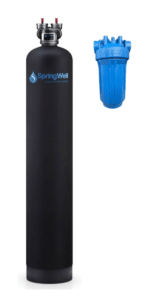
- Filtration technology: KDF & catalytic carbon
- Filter type: Whole house filter
- Chloramines reduction rate: Minimum of 99%
- Contaminants removed: Most water contaminants
- Flow rate: 9 – 17 GPM (1 to 7 bathrooms)
- NSF 42 certification: Not certified
- Warranty: Lifetime

- Filtration technology: High-performance catalytic-activated carbon block technology
- Filter type: Cartridge-based whole house filter
- Chloramine reduction rate: Unspecified
- Contaminants removed: Unspecified
- Flow rate: 15 GPM (1 to 6 bathrooms)
- NSF 42 certification: Not certified
- Warranty: Lifetime
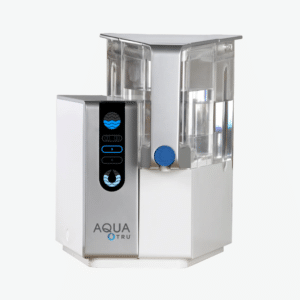
- Filtration technology: Activated carbon + reverse osmosis
- Filter type: Countertop reverse osmosis system
- Chloramine reduction rate: Minimum of 95%
- Contaminants removed: 82
- Filtered water capacity: One gallon
- NSF 53 certification: Certified
- Warranty: One year
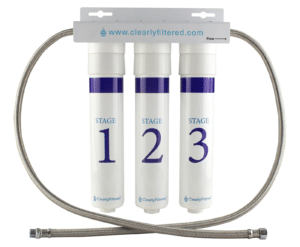
- Filtration technology: Clearly Filtered 3-stage filtration tech
- Filter type: Under-the-sink system
- Chloramine reduction rate: Minimum of 95.3%
- Contaminants removed: 232+
- Filtration capacity: 2,000 gallons for each filter (lasting roughly a year)
- NSF 42 certification: Certified
- Warranty: Lifetime
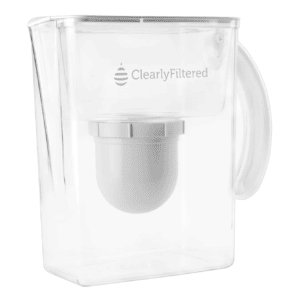
- Filtration technology: Affinity Filtration
- Filter type: Water pitcher
- Chloramine reduction rate: Minimum of 99.7%
- Contaminants removed: 365+
- Filtration capacity: 100 gallons for each filter (lasting roughly four months)
- NSF 42 certification: Certified
- Warranty: Lifetime
1. Remove Chloramines with Catalytic Carbon Filtration
Catalytic carbon filtration is a variation of activated carbon filters, and it’s an effective way to remove contaminants like chloramine.
When traditional activated carbon is processed through gas at high temperatures, its surface structure gets stronger. The end result is catalytic carbon that can break chloramine down to its components, and unlike activated carbon, it renders both chlorine and ammonia harmless.
Moreover, apart from dismantling chloramine, catalytic carbon also reduces the levels of hydrogen sulfide and volatile organic compounds (VOCs).
2. Remove Chloramine with Reverse Osmosis (RO)
Reverse osmosis is a great way to remove chloramines from water. It contains several carbon pre-filters that can remove contaminants as small as 0.001 micrometers. RO is a slow process in which contaminants — including chlorine and chloramine — are removed when the water passes through a semi-permeable membrane.
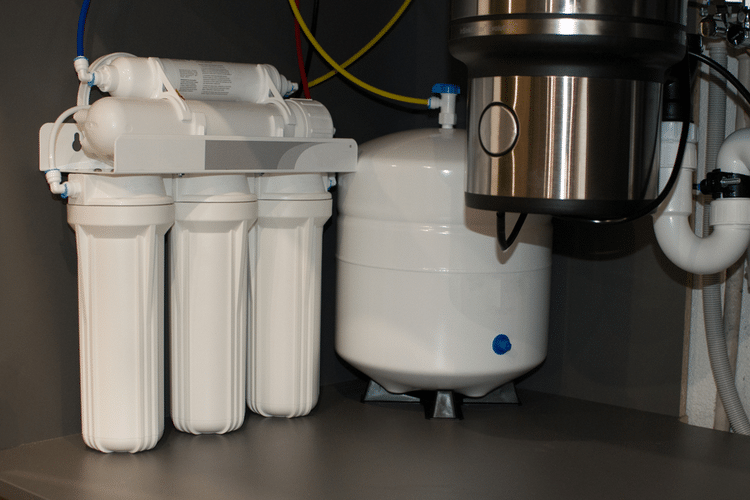
Chloramine is a very stable compound, so breaking it down can be challenging. Thankfully, the carbon filters in an RO system supplement the membrane to prolong contact time with the incoming water, which completely breaks up chloramine.
Which RO system should you get? We recommend Waterdrop G3 800 filter or Aquatru.
3. Remove Chloramines with Ultrafiltration
Ultrafiltration is yet another efficient method to get rid of chloramines in water. This method uses a hollow-fiber membrane to trap contaminants commonly found in tap water, and in part, it also removes chloramine.
The ultrafiltration and carbon filters create a double protection system that can remove as small as 0.025-micron contaminants from your water, making it safe to drink and use at home. That said, ultrafiltration can only remove up to 95% of chloramine from water. The good news is that the remaining 5% isn’t likely to cause health issues since it’ll still probably be less than the acceptable chloramine levels in water (4 mg/L).
4. Remove Chloramines with Activated Carbon Filters
Activated carbon filtration is considered a good RO alternative since it leaves healthy minerals intact. Moreover, it’s also capable of removing chemicals like chlorine and chloramine.
However, some skeptics claim that while activated carbon effectively removes chlorine, it doesn’t do much to remove chloramines. That’s because ammonia is highly stable and requires prolonged contact between the water and the filters to dissolve, which activated carbon can’t provide.
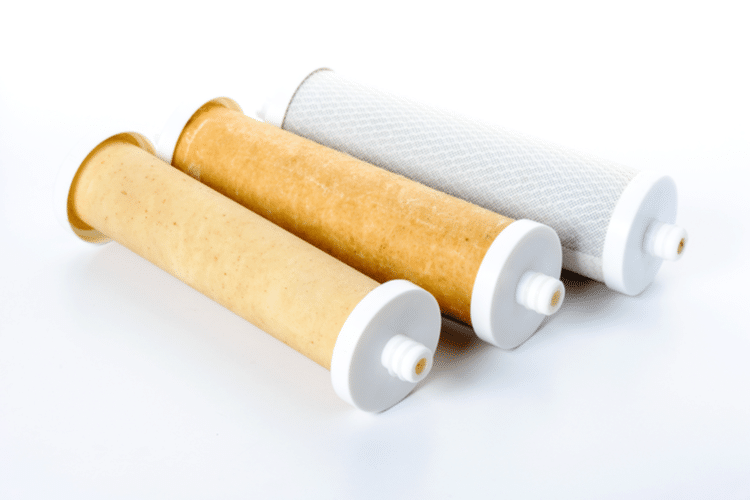
Therefore, filtration systems that have short contact with water will only remove chlorine and leave the ammonia in water unscathed, which is still not safe for consumption. Therefore, if you must use a carbon filtration system, opting for catalytic carbon instead of standard activated carbon is a safer and more effective solution.
5. Use Dechlorinating Chemical Products to Remove Chloramines
Given all the options thus far, the quickest solution, albeit not a long-term one, is to use a dechlorinating product. They are cheaper one-off solution that reduces chlorine in water to its chloride form, usually with the help of sodium thiosulphate.
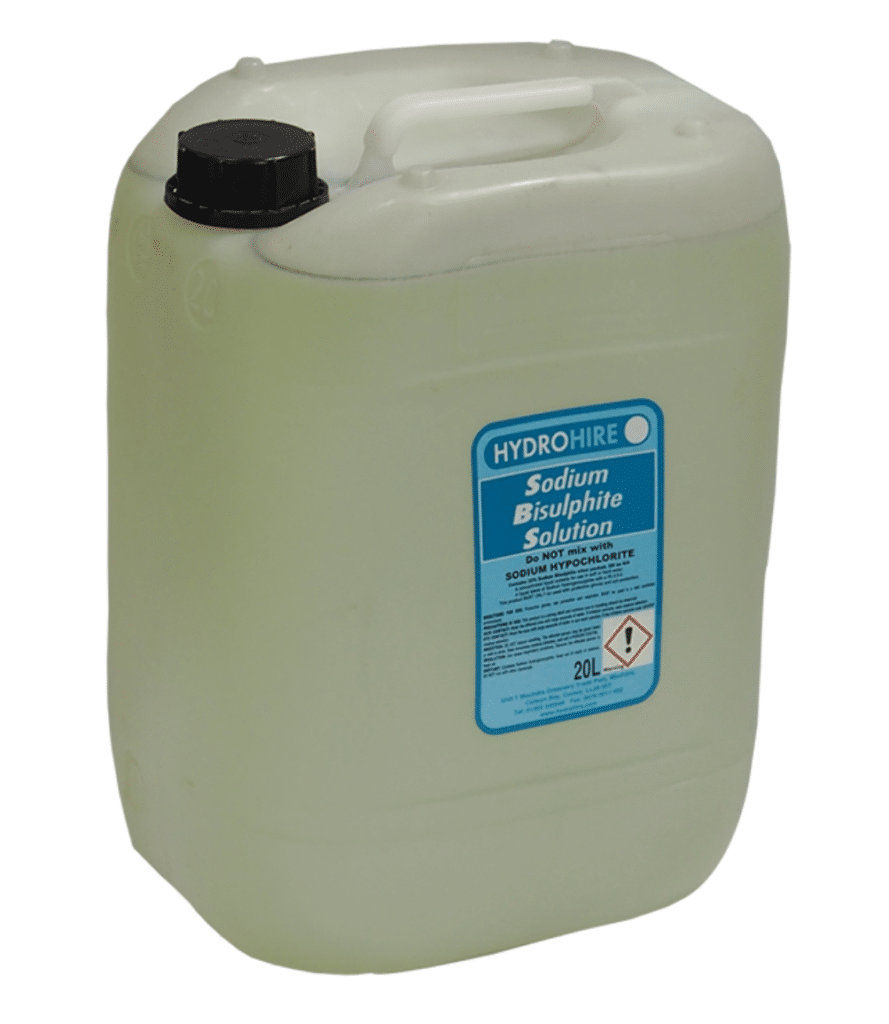
When shopping for a dechlorinating chemical, read the label carefully to verify that it treats chlorine, chloramine, and ammonia. If it doesn’t mention ammonia, the product will only separate chlorine and ammonia, removing only chlorine.
However, when using these products, you can’t remove chloramine as it flows out from your tap. Rather, it’s used for stagnant water bodies like that of an aquarium. So, it might not be the most feasible option for removing chloramine from drinking water.
What is Chloramine and Why It Should Be Removed?
Chloramine doesn’t exist naturally as an element or compound. Instead, it is formed when ammonia and chlorine react together. Since it’s commonly used in water disinfection, many water supply companies add ammonia to chlorine-treated water which results in chloramine.
As long as this water meets all the EPA regulatory standards, it’s safe for human consumption. Speaking of, the EPA considers chloramine levels up to 4 milligrams per litre (4 mg/L) safe for drinking.
Anything beyond that level can cause adverse health complications such as:
- Changes in blood lead levels
- Eye/nose irritation
- Shortness of breath
- Skin itches/rashes
- Swollen/red eyes
Additionally, for patients undergoing kidney dialysis, drinking chloramine-contaminated water can be catastrophic as it can contaminate dialysis fluid and find its way into the bloodstream. It will then alter the hemoglobin which can lead to death.
Identifying the Source of Chloramine in Your Water
Step 1: Identify the Source:
The first question you need to ask yourself is who facilitates your home water supply?. If it’s the municipal water supply companies, then this is the likely source. The use of chloramine to treat public water started way back in the 1930s. Public water supply companies use it as a secondary disinfectant to prevent bacterial growth and other harmful contaminants.
So, the most straightforward way to find out if your water company is the source of chloramine is to call them.
Step 2: Test Chloramine Levels in Water
How do you test your water to determine the chloramine levels? There isn’t an EPA-approved direct method to establish chloramine levels in water. However, the EPA has approved methods to measure free chlorine and total/combined chlorine levels in the water, which also gives us the number of chloramines.
Free chlorine refers to the amount of chlorine that is yet to combine with water contaminants. On the other hand, total chlorine is a combination of free chlorine and chloramines since it also counts the chlorine molecules that have interacted with ammonia. So, to determine chloramine levels in your water, you just need to subtract the number of free chlorines from the number of total chlorine.
Either way, make sure to use EPA-approved test kits to get an accurate estimate.
Step 3: Choose an Effective Treatment Method
Having identified the source and tested your water, you can then proceed with one of the following methods, depending on your budget and the severity of the problem:
- Reverse osmosis
- Ultrafiltration
- Catalytic carbon filtration
- Activated carbon
- Chemical dechlorinating products
Frequently Asked Questions
Most water supply companies use chloramines to disinfect water because they provide longer-lasting disinfection than chlorine. Chloramine is produced by combining chlorine and ammonia, and this reaction forms three different compounds; monochloramine, dichloramine, and trichloramine.
Foul odor and metallic taste are the most common signs of chloramine contamination.
According to the Center for Disease Control and Prevention (CDC), the acceptable chloramine levels in water should be four parts per million (ppm) or up to 4 milligrams per litre (mg/L). Water is safe for human consumption at this level.
The removal cost depends on the preferred treatment method. There are five treatment methods we’ve mentioned above: activated carbon, catalytic carbon, ultrafiltration, reverse osmosis, and chemical dechlorinating products.
For activated carbon filters, either block or granular, the price ranges from $50 to $500. However, you’ll also have to replace its filter cartridge annually, which may slightly raise the overall cost. A catalytic carbon filter, on the other hand, may cost you about $1,000 on average.
Ultrafiltration systems cost between $150 and $200. These units may look cheap but will cost you more in the long run as you’ll have to frequently replace their hollow fiber membrane.
A whole-house reverse osmosis system might cost anywhere between $500 to $8,000. However, if your main concern is chloramine, cheaper alternatives can do the job effectively.
The cheapest way to remove chloramine from water is by using a chemical dechlorinating product. To be sure, buy a 3-in-1 chemical dechlorinating product containing ammonia, chloramine, and chlorine treatment.
Thank you for posting.
It’s helpful
It’s useful to know we’d get our water tested for chloramine levels. My aunt moved to another house last week, but she says that her water has an odd smell and metallic-like taste, so I’ll call her right now to suggest she reads your information. I appreciate your intake on identifying and removing chloramine from our water.